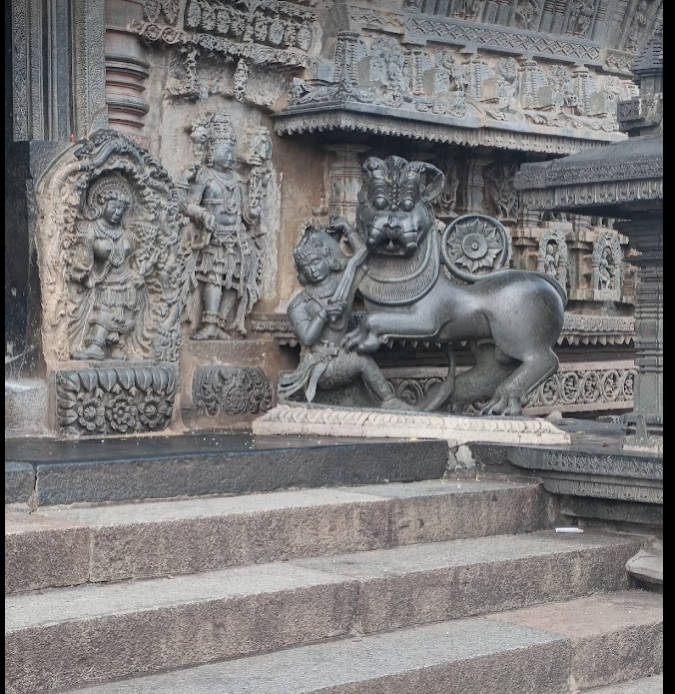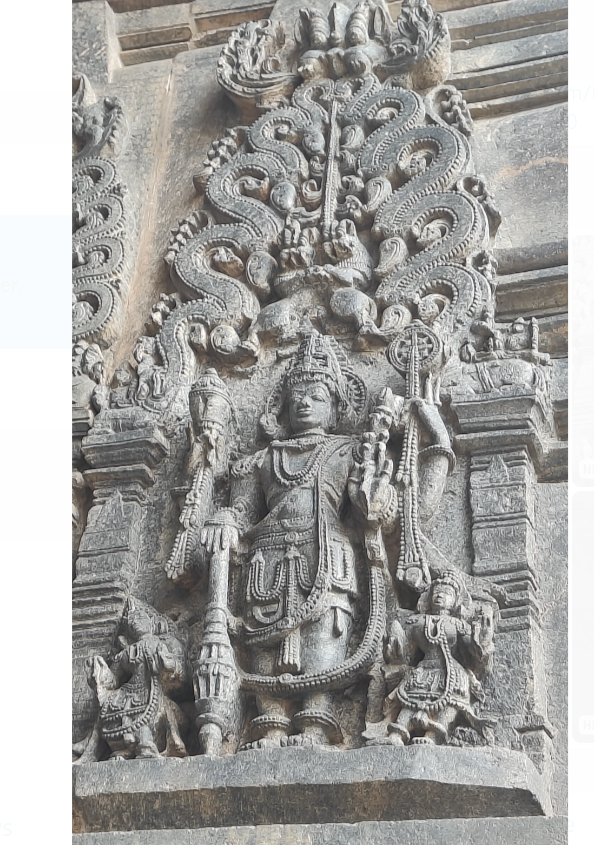There are temples and temples in South India- each one more awe-inspiring than the other! In that list, the Chennakeshava Temple at Belur will stand tall...rubbing shoulders with the very best! This morning, we visited the temple.
The guide at the temple, Mr Nagaraju, began his exposition with the phrase- "You have come to Kalaa-saagara". Art here, is like the ocean- It is vast, it is extensive, it has no boundary. Also, like the ocean, it is deep and simply unfathomable!
I am writing from memory, based on the guide's account to us.
 |
| The temple at a glance! |
The temple was built in the year 1117 (an easy date to remember)! It was built by the Hoysala kings. Pointing to a sculpture of a man with a sword, battling a lion, the guide explained, "The boy's name was "sala". "Hoy" was a call to kill the lion. Thus, came the name Hoysala and an entire dynasty, the Hoysala kings, who ruled for 400 years.
 |
| Hoy-sala! |
This is the Chenna-Keshava temple, about an hour from Chikmagalur in Karnataka. "Chenna" means beautiful. Keshava is of course, Lord Vishnu. Chennakeshava is Lord Vishnu in the form of a lady- Mohini. Vishnu took this form to vanquish "Bhasmaasura". The asura was tricked into touching his own head, and thereby met his destruction, by Mohini!
This is a functional temple (unlike Halebeedu, which is 14 km away). The deity is always dressed as a lady. Lord Vishnu is mohini, the one who captivates and mesmerizes everyone. Lord Vishnu took this Mohini form at Belur, and hence the significance of this particular form here.
It took 103 years to build the temple- spread over 3 generations of kings. The pioneer was King Vishnuvardhana. His earlier name was "Bitti-deva". He was an adherent of the Jaina religion. He became a Vishnu bhakta inspired by Saint Ramanuja.
At the entrance to the temple, we find a frieze where King Vishnuvardhana is seated at the center, his wife Shaantala by his side, and with Saint Ramanuja in the foreground.
 |
| King Vishnuvardhana, Queen Shaantala and Saint Ramanuja |
Hoysala temples are spread over this entire region. 3 prominent ones from this dynasty are- this temple at Belur, another at Halebeedu and yet another at Somanathapura, close to Mysore. While the Belur temple is dedicated to Lord Vishnu, the Halebeedu Temple features Lord Shiva. The Halebeedu temple came under attack from Mallik Kafur (Khilji sultanate in Delhi) around the year 1311. Hence, it is not a functional temple anymore.
No such problem with the Belur temple, the guide says. It has been a functional temple all along.
Though the Belur temple was built in 1117, during the time of the Vijayanagara empire, which was about 500 years ago, a gopuram was built for this temple. We enter the Chennakeshava temple premises through this gopuram. The guide mentions- "Look at the horns at the top of the temple tower. It's shaped like a cow- "go". Hence, the term 'gopuram'!"
 |
| Gopuram built during Vijayanagara time |
The chief architect of this temple was the legendary sculptor "jakanachari" and his son "Dankanacharya". The temple is built in the shape of a star. The pedestal is star-shaped, the main-temple structure seated on top of the pedestal is also star-shaped. The stone used for this temple is "soapstone"- that allows for intricate carving. The principal deity of the Hoysalas was Lord Narasimha. He is seen right at the entrance to the temple.
One of the main attractions at this temple are the dancers and apsaras, striking various poses, delineated with mesmerizing details. We have heard about some of these masterpieces- especially the darpana-sundari....where the lady admires herself glancing into a mirror. Several such pieces adorn the top of the temple; each pose...out-beating the other. These pieces are held in place using "the pivot and joint" technique, the guide explains.
As you go around the temple, the first half of the temple wall is filled with terrestrial themes like the various dance poses. But closer to the garbha-griha, the walls of the temple have themes centered on Lord Vishnu and Shiva. The term "masterpiece" loses meaning as we admire these sculptures. Sculptures of Vishnu and Shiva are scattered all over- as though an entire sack...full of gems was carelessly emptied! There's Shiva as "Gaja-samhaara-murti" with 16 hands. There's Ravana with 10 heads lifting Mount Kailas, and atop the mountain, Shiva and Parvati are seated. We see Arjuna striking the eye of the fish during Draupadi's swayamvara, Lord Brahma is seen with 4 heads and Narasimha gouging out the entrails of Hiranyakashipu! It is a riot- a veritable poetry in stone!
 |
| Shiva and his various forms! |
 |
| Ravana lifting Kailash |
 |
| Lord Brahma |
 |
| Lord Narasimha |
The lower portion of the outer wall has 3 layers- the first layer is filled with a ribbon of elephants in various postures signifying "strength". Above that is a row of lions, symbolizing "courage" and over that, a row of horses signifying "speed". Thus, "strength", "courage" and "speed", together formed the motto of the Hoysala kings!
Once inside the temple, the focus shifts. The main idol is 9 feet tall and imposing. The dwara-paalakas- Jaya and Vijaya arrest your attention. There are pillars all over- each pillar is distinct and different from the other. There are circular pillars, lotus-petalled pillars and even a pillar where the "highlights of the entire temple are summarized in miniature!"
 |
| Pillar with temple summary in miniature |
The ceiling is breathtaking. It is shaped like a wheel. At the center hangs a single-stone (the hub of a wheel) with Lord Narasimha at the hub-base. The hub itself is shaped like a linga and hence it is Lord Shiva. And Brahma too, is seen on the side. Below this wheel (which is on the ceiling) is the dance floor. The dance floor is just outside the main idol. It is here that Queen Shaantala danced. She was an exponent in Bharatanaatyam, the guide mentions. A sculpture dedicated to this queen is also seen on one of the pillars beside the dance floor.
 |
| The ceiling |
 |
| Queen Shaantala |
Outside the main star-shaped temple, there are other attractions. There's a stone-obelisk standing on 3 legs (the guide says), which was installed 500 years ago, during the Vijayanagara period. There's an adjoining structure that looks similar to the main one. The guide says that's the "trial temple" before the main one was constructed. At the back of the main temple, Sri-devi and Bhu-Devi have separate structures.
By this time, we have run out of adjectives. It seems pointless to express admiration anymore through "oo" and "ah" and "wow"!
As we take leave of the guide, he ends just the way he started- this is "kalaa-saagara".
Indeed! There is no other way of describing this place.
 |
| One of the many forms of Vishnu on the temple wall |



No one has captured the architecture better than you. Photos are apt and breath taking sculptures. Historical temples with so much details are very rare. To see and no words can describe them. Hindu religion has so much varities and depth that we have such rich infinite varities to capture.
ReplyDeleteI love this temple and had been there few times. Keep writing.
Ah super!! Thanks so much chitappa that you liked it! Yes, this temple is really beautiful....and each time, it feels as if we are only scratching the surface! There is just so much more to observe each time!!
DeleteYes. We are so much tired of swallowing all details and many of them need explanation by an experienced guide
Delete